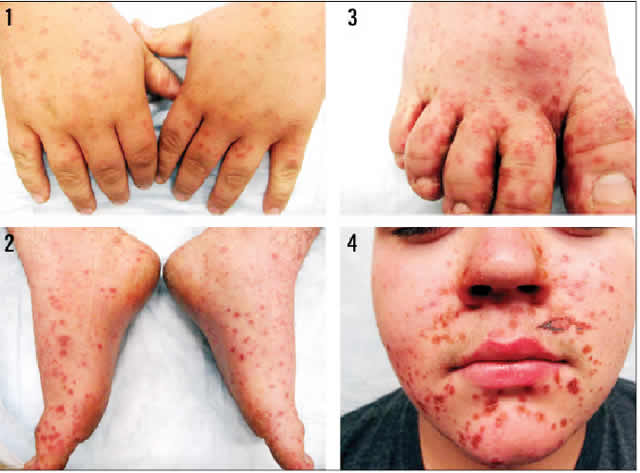Hand, foot and mouth disease affects kids more
On a regular basis, we see children with mouth ulcers and blisters on the hands and feet.
The commonest thinking is that such infections are due to the victim’s poor state of hygiene. However, physicians say that’s not always the case and that what we see is known as the hand, foot and mouth disease.
According to Consultant Paediatrician, Dr. Patience Ejimofor, hand, foot and mouth disease is an infection that is caused by the coxsackie virus. And because ours is a warm and moist climate, the disease can be more common than we know.
Ejimofor says the disease is easy to spread, especially in crowded conditions such as day care centres and school.
“This is because this disease spreads through person-to-person contact, sneeze, sputum and poop,” the physician explains.
He notes that the causative virus lives in the digestive tract and spreads from person to person, usually through dirty hands and also through surfaces that have been contaminated by faeces.
Ejimofor warns, “Even though this disease is more rampant among children, adults can also contact it, hence the need for caution.
“Anyone can contract this infectious disease from coughs, sneezes or when one touches the surfaces that have been contaminated by the virus.”
Once contacted, hand, foot and mouth disease causes blisters on the hands and feet, in the mouth and sometimes in the groin.
Ejimofor says even though the disease is generally mild, it could last for between seven and 10 days before it clears on its own.
She notes that symptoms usually begin to show between three and six days after exposure. And by the time the disease starts taking its toll, victim will begin to show symptoms that include fever, painful blisters on the tongue, gums and inside the cheeks; rash on the palms of hands and soles of the feet.
Other symptoms include sore throat, irritability and loss of appetite.
Ejimofor counsels patients or their parents not to bother using antibiotics to treat the disease.
She says, “Because it’s a viral infection, hand, foot and mouth disease doesn’t respond to any drug therapy, including antibiotics. So, it is useless taking drugs. Rather, when you or your child contact this infection, just make yourself as comfortable as possible while it lasts.”
How the disease spreads
Experts say someone with hand, foot and mouth disease is most infectious from just before the symptoms start until s/he starts to feel better.
Ejimofor says the infection can be spread by close person-to-person contact and contact with contaminated surfaces.
She advises, “The virus is found in the droplets in the coughs and sneezes of an infected person. So, anyone who comes into contact with an infected person can be infected if they get the droplets on their hands and then touch the mouth. The same thing happens when the droplet is inhaled.
“Again, an infected person can infect many people if s/he doesn’t wash the hands properly after using the toilet. When such a person touches any surface, whoever touches that surface risks being infected.”
Moreover, the physician warns, if anyone kisses an infected person and takes in the saliva; or if anyone touches the fluid oozing from the blisters and touches his own mouth, it can lead to infection.
Worse still, experts say, since this infection is caused by different viruses, one can be infected more than once.
The good news, Ejimofor says, is that most people can develop immunity to the viruses as they get older.
Managing the symptoms
- Drink plenty of fluids to avoid dehydration. Water or milk is ideal. For babies, give smaller but more frequent bottle or breast milk feeds.
- Eat soft foods such as mashed potatoes, yoghurt and soups if eating and swallowing is uncomfortable. However, avoid hot, acidic or spicy foods and drinks.
- Take over-the-counter painkillers such as paracetamol, to ease a sore throat and fever.
- To beat the sore throat, gargle with warm, salty water. This will relieve discomfort from mouth ulcers.
- Children who are not able to gargle with warm, salty water can use mouth gels, rinses or sprays for mouth ulcers. Ask your doctor for advice.
- Keep your child away from school until s/he feels better.
And though this disease heals on its own, Ejimofor says there may be need to see the doctor if the affected child is unable to drink any fluids and also if the child shows signs of dehydration, such as unresponsiveness, passing small amounts of urine or no urine at all, or cold hands and feet.
Ejimofor also says a child should be taken to the hospital if s/he develops seizures, confusion, weakness or a loss of consciousness.
She advises, “If a child who is under three months old contacts this disease and the child develops high temperature, s/he must see the doctor.
“Again, if the skin becomes very painful, red, swollen and hot, or if there’s pus discharge, see the doctor.
“And if the symptoms are getting worse or haven’t improved after seven or 10 days, see the doctor.”
PUNCH.








